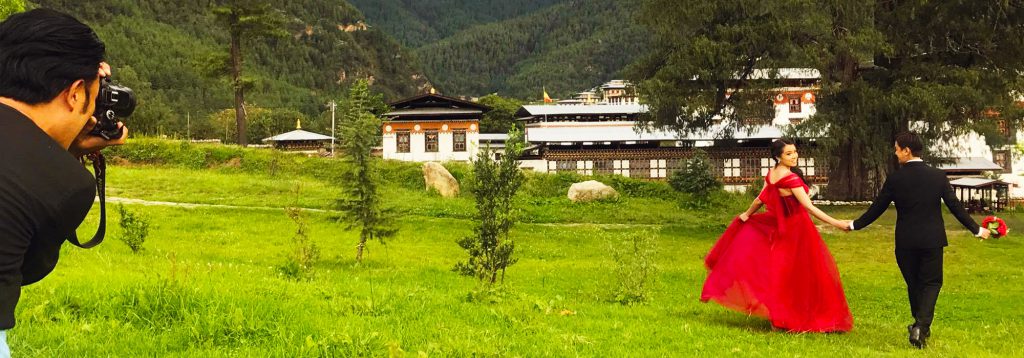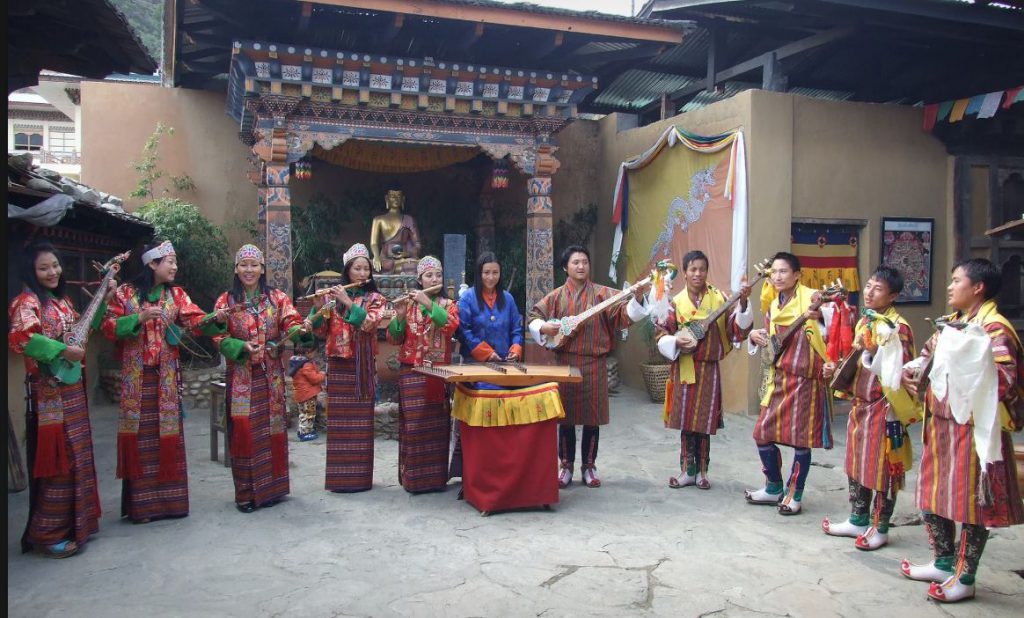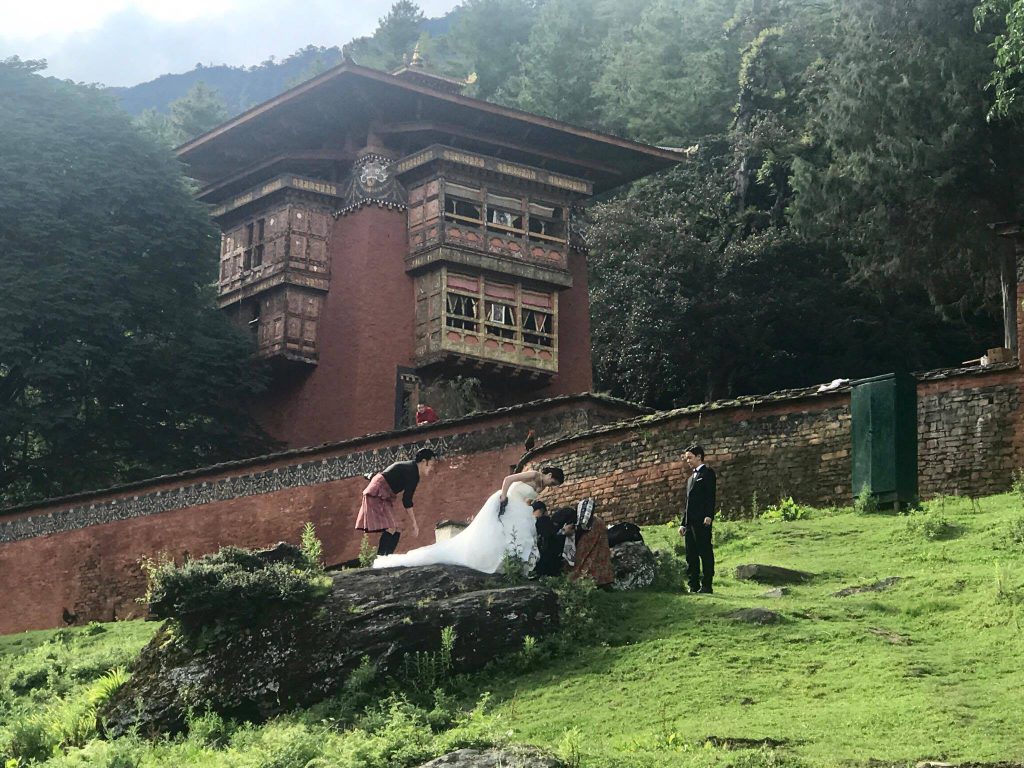
Highlight: Lavish Bhutan wedding with sacred religious traditional blessing, photography, Bhutanese traditional costumes, blessing by buddhist masters, special ceremony in a sacred ancient temple.Bhutan tour and wedding photography.
Description : Bhutan has a unique cultural heritage which has its roots in Buddhism. The Bhutanese people have successfully kept its culture and traditions intact until this day.

Spirituality exists in everyday life of Bhutanese people, therefore in Bhutan a wedding is a celestial union of mind, body and soul of two people. Bhutan has became one of the most popular wedding country now, with celebrities and some of the most popular people visiting Bhutan to have their blessed wedding vows in Bhutan.
One of the most renowned person who got proposed and got married in Bhutan is Dew Aung San Su kyi at Tigers nest temple, Hong kong celebrities Carina Lau and Tony Leung Chiu Wai and the list goes on.
Wedding Location : Wedding can be an ancient temple temple ( 1000 year sold sacred temple/shrine ), Resort in or 300 years old heritage Bhutanese home.
Location tours: Thimphu (capital ), Paro valley and Punakha valley.

Fly into Paro, the great snow-capped peaks of the inner Himalayas rise up to the heavens can be seen during clear weather. As the plane approaches Bhutan, if you look down farmhouses as dots on the hillsides can be seen.
As the aircraft enters the Paro valley, you will see Paro Dzong on the hillside overlooking the Paro Chu (river), with Ta Dzong, formerly a watch tower and now the National Museum, above it.
You will be received by the representative of Bhutan, who will be your Bhutan travel guide throughout your tour.
Visit the following:
Overnight at a hotel in Thimphu.
After breakfast Thimphu sightseeing’s includes the following:
After 5 PM we will visit the Tashichho Dzong, “the fortress of the glorious religion”.
This is the centre of government and religion, site of the monarch’s throne room and seat of the Je Khenpo or Chief Abbot. Built in 1641 by the political and religious unifier of Bhutan, Shabdrung Ngawang Namgyal, it was reconstructed in the 1960s in traditional Bhutanese manner, without nails or architectural plan.
Night halt in Thimphu.
Today we will dress up the couple in exotic Bhutanese costumes and prepare them for the wedding. We will then drive to one of the holiest shrines in Thimphu and make the vow arrangements;
The Head monk will preside over the rituals and offer the scarves to the couples. “Bhutanese wedding is much more than an exchange of vows and rings.
It includes a number of religious rites performed by Buddhist monks and lamas. This represents the importance of the bond between two people. This ceremony is also used for renewing marriage vows.
The actual wedding ceremony and blessings for a lifetime of love and happiness takes place at home. This is followed by visits to sacred temples to make more offerings.
Lhabsang purification : The ceremony begins with a ritual in the morning performed by the monks before arriving at the temple.
Butter lamp : Butter lamps are lit inside the temple as an offering to the deities. Before lighting the lamps the bride and groom have to prostate six times; three times to the head monk and three times to the main alter.
Thrisor : Thrisor is a rite of purification and cleansing that is performed by the head monk at the temple. This will clear your bodies, minds, and speech of all past sins
During the ceremony, monks recite mantras and offer fumigation outside the temple to please the local deities. Bhutanese believe that only if the local deities are pleased we can have their blessing and enjoy good health and wealth.
The fumigation is to please their sense of smell and grains added to the fumigation are to quell their hunger. Inside the temple butter lamps are lit and prostrations done. The butter lamps are an offering of light to deities and the most common means of increasing merit.
Changphoe : The offering to the gods and deities in a form of liquor. After an offering is made to the deities, the liquor (ara) will then be served to the bride and the groom in a traditional wooden phop. (cup), which they will share. This symbolises the faith and everlasting bond the husband and the wife will share for the rest of their lives.
Tsephamey Choko : Tsephamey Choko is a long ritual that is performed in honor of Tsepamey; the God of longevity. It is performed by the head monk to give you a long and happy life together. It is followed by the bride and groom being blessed by the head monk.
Zhugdrey Phunsum Tshogpa : Food and drinks are now offered to deities and the people at the ceremony. This represents unity, wealth, and glory, and in no way should be refused. Normally oranges are used, as they are attractive, taste good, and represent unity. As well, the actual fruit is protected under a layer of skin, which symbolizes security and protection.
Dhar Nayanga : This is the last part of a Bhutanese wedding. Five colored scarves are given to the bride and groom as well as wishes for a happy, prosperous, and everlasting marriage
In addition to these traditions, the bride and groom should be wearing traditional Bhutanese costumes to show respect for this sacred ceremony. This means that the bride will wear a Kira and the groom will wear a Gho.
Option: After the wedding we will drive to the Bhutan post office and take photo to make Stamps of the wedding, which us usable in any part of the world.
We will be driving to some of the best spots in Capital (Temples, mountain side and other beautiful landscapes to take photo of the couple who will be dressed colorfully.
In the evening we will have dinner in one of the Heritage Farmhouse/or simply Bhutan restaurant in Thimphu and also a private 1 hour cultural program will be organized for the married couple.
The beautiful day will finish with great Bhutanese authentic food and traditional Bhutanese Ara/Wine.
Overnight in Thimphu.
Sightseeing and Photo shoot at the Dochula Mountain pass (Half day photo shoot )
After breakfast, travel to Punakha through Dochula Pass (3,088m/10,130ft). If you have a clear sky, the view of the Himalayan Mountain ranges spectacular and you can even see the Gasa Dzong as a white dot in the horizon.

Visit the beautiful 108 chortens built on the hill by Her Majesty Ashi Dorji Wangmo for the security and well being of His Majesty the King of Bhutan.
Travel onto Punakha, the old capital of Bhutan and presently the winter residence of the central monk body.
Visit the Punakha Dzong, located on the island of the Pho – Chu (male) river and the Mochu (female) river. Evening, walk through the Metshina Village and take a 20 minute walk through the rice fields to the Devine Madman’s Monastery-Chhimi Lhakhang, famously known for its fertility shrine, where one can receive a special fertility blessing .
Overnight at a hotel in Wangdue/Punakha.
After breakfast, we will drive to Paro. Visit Kichu temple, one of the 108 temples built in the 7th century by the Tibetan King Songsten Gampo.
The story goes that a giant demon lay across the whole area of Tibet and the Himalayas and was preventing the spread of Buddhism. To overcome her King Songtsen Gampo decided to build 108 temples, which would be placed on all the points of her body. Of these 108 temples, 12 were built in accordance with precise plans.
Thus, it happened that in about the year 638 AD the temple of Jokhang in Lhasa was built over the very heart of the demon.
In the afternoon stop in Paro town and visit some of the popular coffer house and relax.
Night halt in Paro
After breakfast, drive up to the base camp of Taktsang and then hike up to the most famous Monastery in the entire kingdom of Bhutan perched on the edge of a steep cliff, about 900 meters above Paro Valley. The hike to the viewpoint will take about an hour and it will take 2 hours to the monastery.
Lunch at the viewpoint or at Paro town. Later sightseeing in town and Kichu Lhakhang. The 1300 years old Jo Jampa Temple. Overnight at a hotel in Paro.
In the morning, your tour guide from Yelha Bhutan Tours & Travels (local Bhutan travel agent) will escort you to Paro International Airport for your
departure.
—————————————————